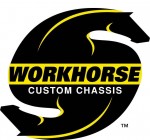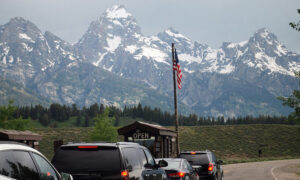
This tip provided by the Workhorse Chassis Technical Team
 Workhorse has found that drivers often overheat and damage their vehicle braking systems by improper braking in mountain areas or by “riding” the brakes on flat ground. The following includes suggestions from the Workhorse Technical Team as well as recommendations outlined in the DOT (Department of Transportation) commercial driver’s license manual. Workhorse has included these DOT procedures in its owner’s manual since 2007 and they apply to all types of motor homes.
Workhorse has found that drivers often overheat and damage their vehicle braking systems by improper braking in mountain areas or by “riding” the brakes on flat ground. The following includes suggestions from the Workhorse Technical Team as well as recommendations outlined in the DOT (Department of Transportation) commercial driver’s license manual. Workhorse has included these DOT procedures in its owner’s manual since 2007 and they apply to all types of motor homes.
In mountain driving, gravity plays a major role. On any upgrade, gravity slows you down. The steeper the grade, the longer the grade, and/or the heavier the load — the more you will have to use lower gears to climb hills or mountains. In coming down long, steep downgrades, gravity causes the speed of your vehicle to increase. You must select an appropriate safe speed, and then use a low gear and proper braking techniques.
You should plan ahead and obtain information about any long, steep grades along your planned route of travel. If possible, talk to other motor home or truck drivers who are familiar with the grades to find out what speeds are safe. You must utilize engine braking techniques to go slowly enough so your brakes can be utilized for speed reduction without getting too hot. If the brakes become too hot, they may start to “fade.” This means you have to apply them harder and harder to get the same stopping power. If you continue to use the brakes hard, they can keep fading until you cannot slow down or stop at all.
Select a “safe” speed
Your most important consideration is to select a speed that is not too fast for the:
- Total vehicle and cargo weight.
- Length of grade.
- Steepness of grade.
- Road conditions.
- jWeather.
If a speed limit is posted, or there is a sign indicating “Maximum Safe Speed,” never exceed the speed shown. Also, look for and heed warning signs indicating the length and steepness of the grade.
You must use the braking effect of the engine as the principal way of controlling your speed. The braking effect of the engine is greatest when it is near the governed rpms and the transmission is in the lower gears. Save your brakes so you will be able to slow or stop as required by road and traffic conditions.
Select the right gear before starting down the grade
Shift the transmission to a low gear before starting down the grade. Pay close attention to the gear that is required to climb the grade prior to decent. For example if the gear required to climb the grade is 3rd gear, then 3rd gear should be selected prior to the decent as a base line to control your vehicle speed. Do not try to downshift after your speed has already built up above the safe posted speed limit. Once your speed has increased over the safe posted speed limit you may not be able to shift into a lower gear. You may not even be able to get back into any gear and all engine braking effect will be lost.
With motor homes, a rule for choosing gears has been to use the same gear going down a hill that you would to climb the hill. However, new motor homes have low friction parts and streamlined shapes for fuel economy. They may also have more powerful engines. This means they can go up hills in higher gears and have less friction and air drag to hold them back going down hills. For this reason, drivers of newer motor homes may have to use lower gears going down a hill than would be required to go up the hill. Usually you want the lowest gear that will keep the motor home at or near the speed you want in negotiating the downhill. For example, if you’re going down a six percent grade and wanted to go 35 mph, you would start downshifting and using the brakes to get to an engine rpm that will enable you to maintain a speed at or near 35 mph.
Proper braking technique
Remember, the use of brakes on a long and/or steep downgrade is only a supplement to the braking effect of the engine. Once the vehicle is in the proper low gear, the following is the proper braking technique:
- When your speed increases to or above your “safe” speed, apply the brakes aggressively enough to feel a definite slowdown.
- When your speed has been reduced to approximately five mph below your safe speed, release the brakes. (This brake application should last for about three seconds.)
- When your speed increases again to your safe speed, repeat steps 1 and 2.
For example, if your safe speed is 40 mph, you would not apply the brakes to any increase in speed until you reach 40 mph. Then you apply the brakes aggressively enough to gradually reduce your speed to 35 mph and then release the brakes. Repeat this as often as necessary until you have reached the end of the downgrade.
Brake fade or failure
Your brakes by design operate utilizing brake pads that rub against the brake disks to slow the vehicle during brake application. This braking function creates heat, which the brake system can dissipate during normal brake applications. However, brakes can fade or fail from excessive heat caused by improper use or dragging the brake to slow the vehicle on mountain grades rather than relying on the engine braking effect. To safely control a vehicle, every braking mechanism must do its share of the work. Brakes with excessively worn pads or rotors will not provide the same degree of braking power. If you are not sure about the condition of your braking system, have it inspected by qualified service center.
Escape ramps or runaway truck ramps
Escape ramps, also known as Runaway Truck Ramps, have been built on many steep mountain downgrades. Escape ramps are made to stop runaway vehicles safely without injuring drivers and passengers. Escape ramps use a long bed of loose, soft material to slow a runaway vehicle, sometimes in combination with an upgrade. Know escape ramp locations on your route. Signs show drivers where ramps are located. Escape ramps save lives.
An example of brake-friendly driving technique in Death Valley
On a recent trip to California we made notes on driving technique when descending a mountain pass.
Background:
The motor home was built on a Workhorse W22 gas chassis, fully laden to 22,000 lb. GVWR. The driver, let’s call him Mike, is an experienced driver with a valid Commercial Driver’s License and is also a professional automotive technician. We asked Mike to drive the vehicle in a fashion that would conserve the brakes, but also be reasonable in using the engine and transmission for braking (i.e. drive it like you own it!).
We were traveling in a south-westerly direction into Death Valley National Park from the Nevada side on SR-374, with a planned stop at Stovepipe Wells Village in the park. This is quite a steep descent with almost 10 miles of 7 percent grade and 4 miles of 5 percent grade, with a total drop of around 4,000 foot over 12 miles of driving. The speed limit on some road sections inside the National Park on this road is 45 mph, so Mike shifted down to second gear as soon as we hit the down-grade. The motor home was a 2005 model with the 5 speed Allison transmission and equipped with the “Grade-Brake” feature, but Mike elected not to use the Grade Brake, instead preferring to manually shift down using the column shift.
Mike would allow the vehicle to run against engine compression with the engine speed varying between 4,000 rpm to 5,200 rpm, depending on the grade. Each time we hit 5,200 rpm the transmission would force a shift to 3rd in order to protect the engine. Each time this happened Mike applied the brake for a few seconds to scrub off speed and this allowed the transmission to downshift to 2nd gear again, allowing maximum engine braking in the safe speed range. Drivers should not be concerned about the high rpms in this situation because, as noted, the transmission will automatically adjust when needed to protect the engine. Also, if Mike had elected to use the Grade Brake feature, the down- and up-shifting would have happened automatically once he touched the brake pedal.
Overall, Mike applied the brake only seven times during the 14-mile descent and this includes the final stop at the T-junction with the North Highway! Most of the applications were of short duration, with less than 5 seconds of brake pedal application required to control the vehicle speed.
Only once did Mike use the brake pedal for longer on a twisty section to ensure we remained at a safe speed. The total time of brake application was only around 45 seconds. This was quite an enlightening illustration of how driving technique learned on heavy trucks (where brakes simply do not have the huge excess capacity found on passenger cars) can allow for safe navigation of the most demanding descents with no danger of overheating and damaging the brakes on your motor home.







This was impressive. I also hold a CDL/H and that is how I have driven for the last 40+ years. All too often I see RVs swooping by me on downhill grades only to end up somewhere on the side of the road later on. I stop and usually they have really “Hot Brakes” as well as the front bearings being excessivly hot. That is when I explain the proper downhill techniques. “Go down the mountain one gear lower than used going up”. As usual, it would seem some drivers don’t like constructive instruction. But then- – – I retired from the government and my job was hauling classified cargo. (The kind that leaves “Schroom Clouds”!)so yes, I do have some expertise.
The motorhome used is the same as mine with the exception that I don’t have the “Grade Brake System”. I do tow a Jeep Wrangler that has a “Brake Even” system. I do use that also. I’ve not had any brake problems with the Jeep either. As I do my own maintenance, brakes are part of the process.
Keep the iron up and the rubber down!!
Jon
Great Tips!! May I use this on my website?
Thanks for asking Elaine. Since the article was provided by Workhorse and they have distributed it for free use, you do indeed have permission to use it on your site.